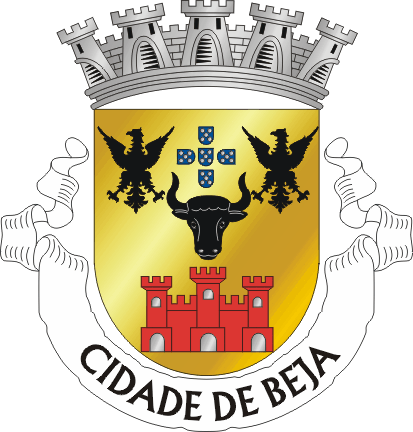Beja: Difference between revisions
Knorrepoes (talk | contribs) m (Text replace - "{|width="100%" style="color:black; background-color:#ffffcc;" |width="15%"|50 px|left |width="70%" align="center" |'''Heraldry of the World<br>Civic heraldry of Portugal - [[Portugal|Brasões dos municípios portu) |
Knorrepoes (talk | contribs) |
||
| Line 28: | Line 28: | ||
*[[Santa Clara de Louredo]]<br/> | *[[Santa Clara de Louredo]]<br/> | ||
*[[Santa Maria da Feira (Beja)]]<br/> | *[[Santa Maria da Feira (Beja)]]<br/> | ||
*[[Santiago Maior]]<br/> | *[[Santiago Maior (Beja)]]<br/> | ||
*[[São Brissos]]<br/> | *[[São Brissos]]<br/> | ||
*[[São João Baptista (Beja)]]<br/> | *[[São João Baptista (Beja)]]<br/> | ||
Revision as of 13:48, 16 December 2015
BEJA
District : Beja
Official blazon
Escudo de ouro, com uma cabeça de touro de negro realçado de prata, visto de frente. Em chefe as quinas antigas de Portugal de azul carregadas por cinco besantes de prata em aspa. A quina e a cabeça do touro acompanhado por duas águias estendidas de negro. Em contra-chefe, um castelo de vermelho, aberto e iluminado de prata. Coroa mural de cinco torres de prata. Listel branco com a legenda " CIDADE DE BEJA " de negro.
Origin/meaning
The arms were officially granted on April 4, 1938.
The bull in the arms represents the abundance of cattle in this region.
The tower shows that Beja was a fortfied town, whereas the eagles are a symbol for the Roman origin of the city. The small blue shields are taken from the Royal arms of Portugal and indicate that the city has always been a Royal city.
Freguesias in Beja :
- Albernoa
- Baleizão
- Beringel
- Cabeça Gorda
- Nossa Senhora das Neves
- Quintos
- Salvada
- Salvador (Beja)
- Santa Clara de Louredo
- Santa Maria da Feira (Beja)
- Santiago Maior (Beja)
- São Brissos
- São João Baptista (Beja)
- São Matias
- Trindade (Beja)
Contact and Support
Partners:
Your logo here ?
Contact us
© since 1995, Heraldry of the World, Ralf Hartemink 
Index of the site
Literature : image provided by Sergio Horta










